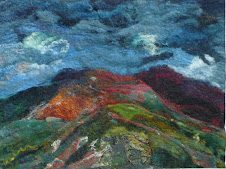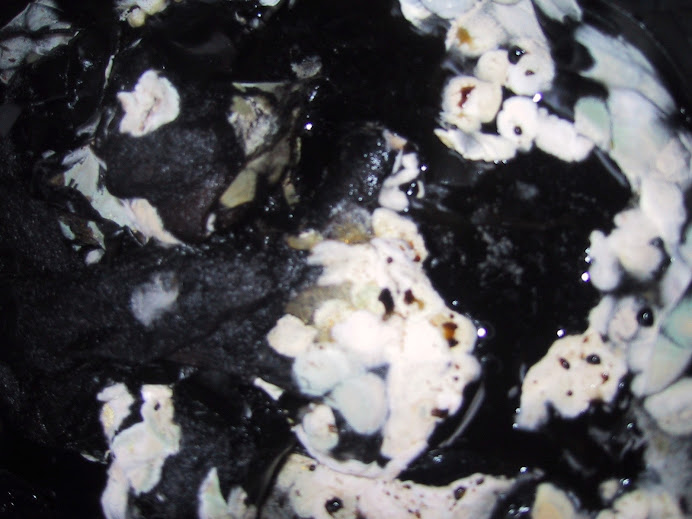

Today Enys and I picked 1.7 kilos of Dyers Chamomile from her garden where it grows better than in mine-why I don't know.
Dyers Chamomile is apparently a European plant that spreads as far as the Himalayas but was not much used in Europe as weld and sawwort were considered better dyes and this probably explains why, although Dominique Cardon1 has a section on the plant pigments found in Dyers Chamomile, she does not have a section of recipes, but nor does Jill Goodwin in the Dyers manual or Su Grierson in Colour Cauldron so maybe it also was not used or does not grow in Scotland or the North of England. John and Margaret Cannon in their lovely Kew Garden book with the beautiful illustrations -by the by one of my favourite and frequently turned to dye books- mentions that Dyers Chamomile was used to dye the Turkish carpets2 although Dominique Cardon says that this was the wild chamomile . Jenny Dean in Wild Colour 3has a page for dyers chamomile and also used the plant stem and leaves to get a soft green , something I must try this year.
All those who do talk about Dyers chamomile say that it is easy to grow which it is. You can often get it in garden centres as it is very pretty plant to have in the garden. It also dries extremely well with no apparent loss of pigment in the drying process but is considered to have a poorer light fastness than weld. My own light fastness tests were done a few years ago when I kept my samples for a year in in a north facing window when there was a significant loss of colour. Now I follow a more standard procedure mentioned on Natural Dyes Online and expose to light in a southwest facing skylight for a month with a standard indigo dyed sample alongside as a control. This I need to do this year .
I have been reading about the chemicals that give the dye colours in these plants. The general group the dye pigments come under is the Flavonoids and when these are dilute they are almost colourless. It is only when the molecules are clumped together or when they are bonded to metal ions that they appear yellow. A mordant therefore not only bonds the dye molecule to the fibre but is also essential in intensifying the colour and this would explain why John and Margeret Cannon commented that wool without a mordant was almost colourless.
Like so many dye plants dyers chamomile has a number of different plant pigments, Apigenin (which was the only pigment in wild chamomile) and is also found in weld, and luteolin also found in weld. Apigenin and luteolin are flavones. I mention weld as I wondered why when dyers chamomile shares at least two of the pigments found in weld which produces one of the most light fast yellows that dyers chamomile is not as light fast. Apparently according to Dominique Cardon from whom most of this information comes, this is because minor variations in the structure of the molecule is highly significant. The other pigments , according to Margaret and John Cannon in Dye plants and Dyeing are the flavonols quercetagetin, and one I can find nothing about, patuletin. The flavonals are more light sensitive. I went into all this because I was reading a paper about growing Weld (reseda Luteola) Dyers knotweed (polygonum tinctoria) and Dyers chamomile written by Anna Hartl and Christian Vogl ( The Potential use of Organically grown Dye Plants: experiences and results on cultivation and yields of Dyers chamomile, Dyer knotweed and Weld published in the Journal of Sustainable Agriculture 23(2) 2003. Here the author said that the main components of dyers chamomile had have not yet been identified,which I found most surprising and what started me off on reading my various books.
I can understand why Dyers chamomile would be considered as a source of yellows for the organic textile trade as it is easy to grow and apparently to harvest. Think how gorgeous fields full of dyers chamomile would look too so I hope that it does happen.
In the meantime I have put 200g of flower heads into soak ready to be a demonstration for members of the WI who are to visit the garden tomorrow.
(My footnotes with the titles of the books will not transfer over- why I don't know -sometimes blogging is so frustrating!)



























Good pics. If I can ever have a garden again, I will include this.
ReplyDeleteInteresting about the pigments and the chemicals. I can see how that could be a whole study all in itself.
This is great info - thanks. I really love reading your deep envolvment with dyeing. I feel like I just dabble next to you - thanks for all your blogging
ReplyDeleteI prefer the chamomile to the weld - because it grows better here:) I don't really do dyeing for heirlooms that have to keep their colours for decades and I like the strong yellow the dyer's chamomile gives me. though I was rather surprised two years ago: I usually find that yellows treated with iron give greens, that go well with the yellow of the same plant. to my surprise the green I dyed with the d. ch. plus iron didn't go at all well with the strong yellow of the first batch! it looked kind of dirty compared to the clear yellow.... I stopped drying the flowers as they have a tendency to go mouldy here before they are dried thoroughly (irish summer!) - I put them into freezer bags and they dye just as well (I know, not good for the eco-footprint - but mouldy flowers don't give nice colours:)
ReplyDeleteDeep involvment in the dyeing is the word! Yesterday I had a vsit from the WI to the garden ( 12 very nice ladies) one of them asked me what I did to relax and I was nonplussed as dyeing and felting is what I used to do to relax and now takes up all my time. Prehaps bloggin is my realaxation -Leigh encouraged me to start and I love it! It's the sense of contact with likeminded people I love.
ReplyDeleteThanks Bettina about the tip for freezing. For some reason it does not occur to me. I spread the dyers camomile on trays in a sunny room and they seem to be fine. I love the colour -warmer than Weld usually I find.
Deep involvment in the dyeing is the word! Yesterday I had a vsit from the WI to the garden ( 12 very nice ladies) one of them asked me what I did to relax and I was nonplussed as dyeing and felting is what I used to do to relax and now takes up all my time. Prehaps bloggin is my realaxation -Leigh encouraged me to start and I love it! It's the sense of contact with likeminded people I love.
ReplyDeleteThanks Bettina about the tip for freezing. For some reason it does not occur to me. I spread the dyers camomile on trays in a sunny room and they seem to be fine. I love the colour -warmer than Weld usually I find.
I tend to freeze quicker than dry - because the irish climate is quite damp and I don't have a spot where to dry things properly! the downside of course is not only the use of energy (but on the other hand I was told that the freezer uses less energy wenn well filled:)) - but the lack of space, when you want to preserve a lot of material! and not all dyes turn out the same from frozen or fresh material - gorze flowers come to mind! but most so far did for me - trial and error, just the usual with natural dyeing:) and I gave in with the solar dyeing, I put my jars into the e-canning pot to heat them up very slightly - no sun in sight here:(
ReplyDeleteHave you tried any of things that India Flint suggests-freezing flowers and then using them to dye with. The colour runs out aapparently. A friend of mine tells me she freezes madder and the colour comes out easily when thawed. Another lot of intersting experiments I think!
ReplyDeletelate comment, I know - but we had no internet for days, because we tried to switch over to broadband (which didn't work at first!). I started to freeze the ripe berberis darwinii berries that India mentions in her book. and I froze part of my delphinium flowers, but I didn't test them, I want to collect some more first! I think freezing flowers is ideal where you don't have large amounts in one go, such as dahlias, which I pick when they are past their best! definitely much room to explore.... I also got a mail from a friend who managed to get some roots of indian madder - I am looking forward to try more of this. my plant died, and I only ever used the leaves and stalks, not the roots. but the asian grown roots are supposed to be very strong in pigment!
ReplyDeleteHaving just taken a batch of dried Anthemis tinctoria (called golden marguerite here) off the woodstove and ended up with a much richer color than expected, on a wool/nylon blend. It seems to have more golden orange tones than I expected. Will have to take a better look at it in the morning in natural light.
ReplyDeleteI dry them as they come into full bloom on those woven, rattan paper plate holders used for picnics, found secondhand for pennies: http://www.jensco.com/thekitchendrawer/grilling_outdoor/serving_table/serving700.html
It's quite dry here in the summers, though, so the blossoms dry rather quickly.
Hi, well be sensible, well-all described
ReplyDelete